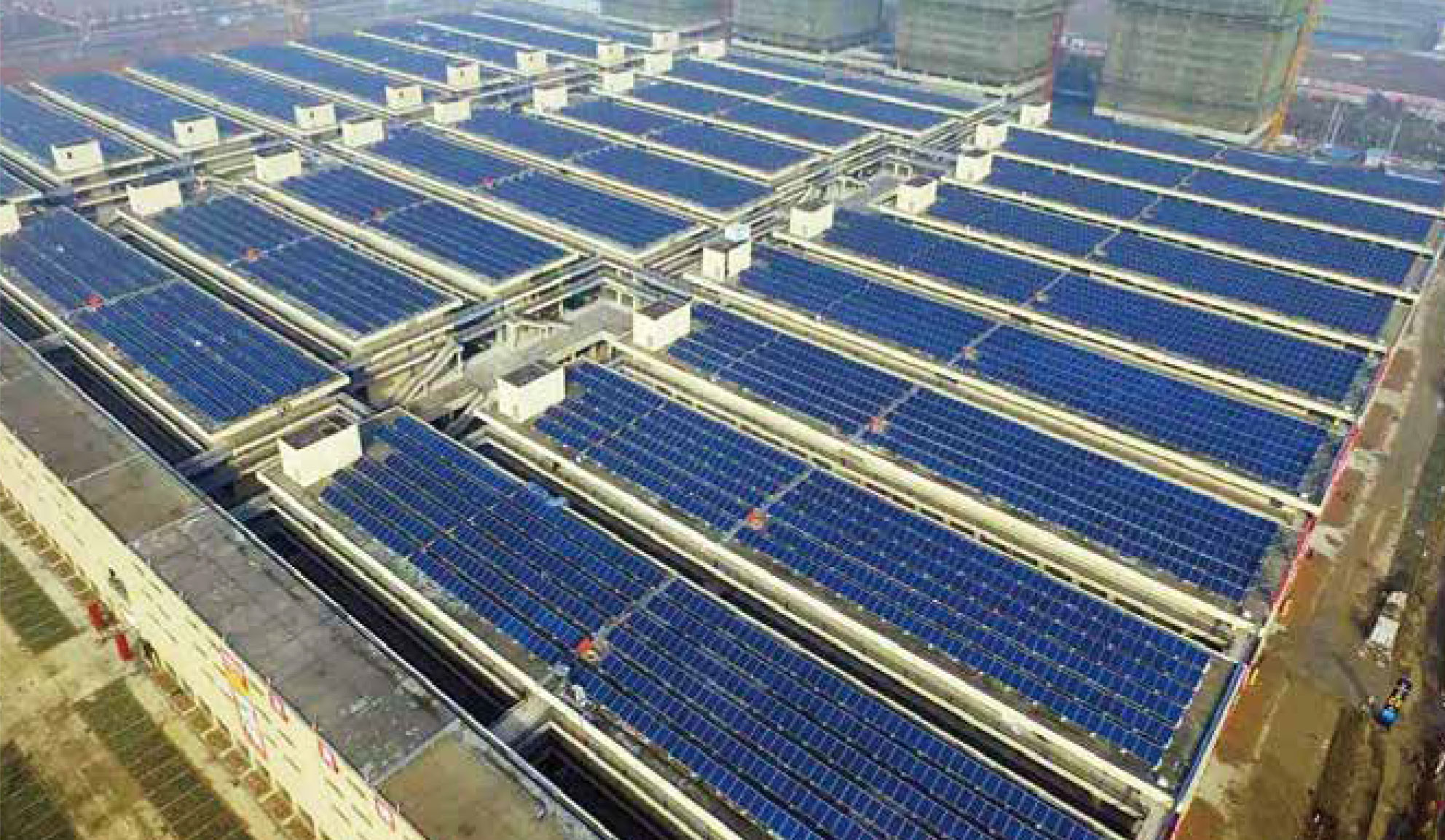分布式光伏发电的工作原理介绍
分布式光伏发电是指将太阳能光伏发电设备分布在用户用电的地方,通过本地用电和余电回供的方式,理论上可以在一定程度上实现用户的自给自足,或为电网提供电源。以下是分布式光伏发电的工作原理:
Distributed photovoltaic power generation refers to the distribution of solar photovoltaic power generation equipment in the areas where users use electricity. Through local electricity consumption and residual electricity supply, it can theoretically achieve user self-sufficiency to a certain extent or provide power to the grid. The following is the working principle of distributed photovoltaic power generation:
光伏组件吸收日光。光伏组件吸收来自太阳的能量,将太阳光转化为电能。
Photovoltaic modules absorb sunlight. Photovoltaic modules absorb energy from the sun and convert sunlight into electrical energy.
直流电输送。电能经过逆变器的变换作用转化为直流电,然后经过电线输送到矩阵电池中寄存。
Direct current transmission. The electrical energy is converted into direct current through the conversion effect of the inverter, and then transmitted through wires to the matrix battery for storage.
负荷就地供电。直流电再经过逆变器的处理,转化为交流电,供应用户使用,称作就地供电。
Load local power supply. Direct current is then processed by an inverter and converted into alternating current, which is supplied to users for use, known as on-site power supply.
余电回馈。当直流电产生的能量大于用户所消耗的能量时,多余的电能可以回馈到电网中,成为余电供电,即余电输出。
Residual electricity feedback. When the energy generated by direct current is greater than the energy consumed by the user, the excess electrical energy can be fed back to the grid and become surplus power supply, that is, surplus power output.
综合用电与余电回馈供电。用户用电的产生往往呈不稳定的特点,因此分布式光伏发电系统还可以通过综合用电与余电回馈供电的方式,以满足各种用电需求。

Comprehensive electricity consumption and surplus electricity feedback power supply. The generation of electricity consumption by users is often characterized by instability, so distributed photovoltaic power generation systems can also meet various electricity needs through comprehensive electricity consumption and residual electricity feedback power supply.
总之,分布式光伏发电是通过将太阳能光伏发电设备分布在用户用电地方,实现就地供电和余电回馈供电的方式,可以在一定程度上实现用户的自给自足,或为电网提供电源,实现节能减排的效果。
In short, distributed photovoltaic power generation is a method of distributing solar photovoltaic power generation equipment in the user's electricity consumption area, achieving on-site power supply and residual electricity feedback power supply, which can to some extent achieve user self-sufficiency or provide power to the grid, achieving energy-saving and emission reduction effects.
分布式光伏发电的结构组成
The structural composition of distributed photovoltaic power generation
分布式光伏发电系统的结构组成主要包括光伏组件、逆变器、电池储能系统、监测系统等几个部分。
The structural components of a distributed photovoltaic power generation system mainly include photovoltaic modules, inverters, battery energy storage systems, monitoring systems, and other parts.
光伏组件:光伏组件是分布式光伏发电系统中基本的部件,用于将太阳能光线转换为电能。光伏组件一般由太阳能电池片、强化玻璃、背板、边框等组成,其组件类型包括多晶硅、单晶硅、非晶硅等。
Photovoltaic modules: Photovoltaic modules are the basic components in distributed photovoltaic power generation systems, used to convert solar light into electrical energy. Photovoltaic modules are generally composed of solar cells, reinforced glass, backplates, frames, etc. The types of modules include polycrystalline silicon, monocrystalline silicon, amorphous silicon, etc.
逆变器:逆变器是分布式光伏发电系统中的核心部件,将光伏组件产生的直流电转换为电网所需的交流电,并将电网的供电调整为适合光伏组件的直流电输出,以提高分布式光伏发电的效率。
Inverters: Inverters are the core components of distributed photovoltaic power generation systems, which convert the direct current generated by photovoltaic modules into the alternating current required by the grid, and adjust the power supply of the grid to the DC output suitable for photovoltaic modules to improve the efficiency of distributed photovoltaic power generation.
电池储能系统:电池储能系统是分布式光伏发电系统中的储能部件,用于储存组件输出的电能,供给夜间或需求峰值的用电场景。目前较为成熟的电池储能技术主要包括锂离子电池、铅酸电池、钠硫电池等。
Battery Energy Storage System: A battery energy storage system is an energy storage component in a distributed photovoltaic power generation system, used to store the electrical energy output by the components and supply electricity for nighttime or peak demand scenarios. At present, mature battery energy storage technologies mainly include lithium-ion batteries, lead-acid batteries, sodium sulfur batteries, etc.
监测系统:监测系统用于监测整个分布式光伏发电系统的性能指标,包括光伏组件的发电效率、逆变器的转换效率、电池储能系统的充放电效率等,以确保系统的安全和有效运行。
Monitoring system: The monitoring system is used to monitor the performance indicators of the entire distributed photovoltaic power generation system, including the generation efficiency of photovoltaic modules, the conversion efficiency of inverters, and the charging and discharging efficiency of battery energy storage systems, to ensure the safe and effective operation of the system.
支撑架:支撑架是分布式光伏发电的安装组件,可分为分立支撑架和一体支撑架。分立支撑架适用于屋顶光伏电站,一体式支架适用于农业光伏、户外太阳能路灯等。
Support frame: The support frame is the installation component of distributed photovoltaic power generation, which can be divided into discrete support frames and integrated support frames. The discrete support frame is suitable for rooftop photovoltaic power stations, while the integrated support frame is suitable for agricultural photovoltaics, outdoor solar street lights, etc.
总之,分布式光伏发电系统由光伏组件、逆变器、电池储能系统、监测系统及支撑架等组成。它结构简单、技术可靠、施工方便等优点,已经成为清洁能源的重要领域之一。
In summary, a distributed photovoltaic power generation system consists of photovoltaic modules, inverters, battery energy storage systems, monitoring systems, and support frames. It has become one of the important fields of clean energy due to its simple structure, reliable technology, and convenient construction.
感谢您的阅读,此文的文章来源:分布式光伏发电更多的内容和问题请点击://tianjibiotech.com我们会继续努力的为您提供服务,感谢您的支持!
Thank you for reading. The source of this article is Distributed Photovoltaic Power Generation. For more information and questions, please click: //tianjibiotech.com We will continue to work hard to provide you with services. Thank you for your support!
新闻推荐
product recommendation联系方式
Contact Information

截屏,微信识别二维码
微信号:18805312017